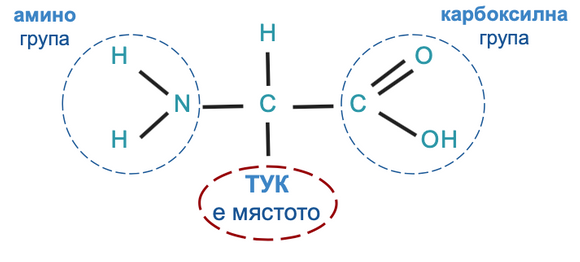Author: Yana Nencheva, Biochemist, PhD candidate in Biophysics
When it comes to egg whites, most people think of poached eggs, omelets and glazes, and biologists think of amino acids. The association of both groups is correct because egg white is made up of about 90% water and about 10% protein (which is made up of amino acids).
You have heard that proteins are good and that they make you healthier and stronger. That's why most people sculpt their bodies, consuming protein shakes and eggs in the morning. But what exactly is a protein? And what are amino acids?
What are amino acids and what is their structure

I will not delve into the structure, but I insist that you imagine each amino acid as a fine, robust skeleton of chemical elements connected to each other.
Note thatin one place there is only a streak without a chemical element and a chemical group tied to it("joint"). In the case of the general formula of alpha-amino acids, this is an empty space that can be taken up by various chemical elements. The term used for what is attached there is radical ( andismarked with R). And according to the radical (R) - we have a different amino acid with a different name. It depends on what its properties will be and, accordingly, what the body will use it for.
Thus, in summary, the amino acid is made up of:
- Amino Group (NH2)
- Carboxylic group (-COOH)
- Radical (R)
These are elements and groups that are thought to have formed since the birth of planet Earth [ref. 1]
Amino acids [ref. 2], of which the proteins in the human body are made up are 20 in number. Otherwise, there are 300 more amino acids in nature, but our bodies use the 20 and they seem to have enough. Each chain is built on a model, scheme, command (if you will), the information about which is in our DNA. DNA transmits this information in the form of a copy of RNA (the process is called transcription). Then the RNA "translates" the received command into the "language of proteins" (the process is called translation) - it says exactly which amino acid to which to attach to the chain. This is an extremely precise process. Eg. the probability of miscopying from DNA to RNA is 1 in 10,000 nucleotide pairs [ref. 3]. It is in this minimal chance of error that mutations are rooted. Imagine how much trial and error it took to look and exist in the form we are now.
What are proteins
Whether we call protein proteins or proteins - no difference - these are synonyms. Amino acids are the building block of proteins that we know as a name from food labels these days.
Proteins are an essential building block of our bodies:
- Hemoglobin is a protein that contains the chemical element iron and which is responsible for breathing,
- Our immune system consists of antibodies that are made up of proteins;
- Muscles are made of fibres that also contain proteins,
- The majority of hormones are of protein nature, etc.
These examples are a small part. Proteins with chains of 60 amino acids are known, and there are those with 1500 [ref. 4]. polypeptidebond, and from there the chains themselves adopt the specific name - polypeptide chains.
But it's not just a chain - it has to be folded in a specific way. The folding of proteins is not a trivial moment. This is a key factor in the performance of their exact functions. It shouldn't be belittled, and the body doesn't. It's not like folding laundry, the wrongly pleated protein needs to be repaired. It is recognized, targeted and voluntarily dismembered to its constituent parts - amino acids. Like a Lego game - if it doesn't work out, it breaks down and repeats itself again. If for some reason the wrong fold is not corrected - a disease can be obtained. This is the case with mutated prions, which turn into infectious protein particles and cause diseases such as Mad Cow, Laughing Death and Fatal Family Insomnia.
